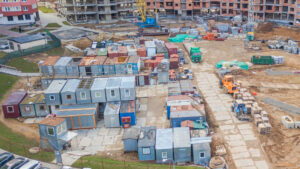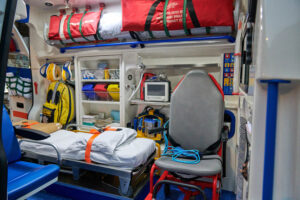
What’s Included in Oil and Gas Facilities Management
Oil and gas facilities management is a complex and critical discipline that ensures energy operations in Canada’s most remote locations

Developing a sustainable infrastructure for a remote camp facility located in the rugged, often isolated regions of Canada—such as the northern territories, boreal forests, or resource-rich mining zones—requires innovative solutions tailored to harsh climates, limited accessibility, and sensitive ecosystems. These facilities serve essential roles in supporting industries like mining, oil and gas, and forestry, often operating far from conventional infrastructure. As environmental regulations tighten and corporate responsibility becomes more important, sustainability is no longer a luxury—it’s a necessity. Through smart planning, modular construction, renewable energy, and efficient resource management, today’s remote camps can minimize their ecological footprint while enhancing the safety, comfort, and productivity of their occupants.
A remote camp facility is typically established in Canada’s vast and often unforgiving landscapes—ranging from the windswept tundra of the Northwest Territories to the dense boreal forests of Northern Alberta or the mountainous mining zones of British Columbia. These camps are critical to supporting operations in areas where permanent infrastructure is either unavailable or economically impractical.
Commonly used by industries such as mining, oil and gas, forestry, and renewable energy, these camps must be self-sufficient, durable, and efficient. Workers may be stationed for weeks or even months at a time, requiring not only functional buildings but also livable environments that provide safety, comfort, and essential amenities.
While these camps are often considered temporary, their infrastructure must withstand extreme weather, remote logistics, and environmental sensitivities—factors that make modular and mobile solutions ideal for efficient setup and sustainable operation.
One of the most impactful strategies for sustainable development in a remote camp facility is the use of modular building systems. These structures are prefabricated in controlled environments and transported to the remote location for assembly. This method significantly reduces waste, construction time, and on-site environmental impact.
Key advantages of modular infrastructure include:
Examples of modular structures that support sustainability:
Energy supply remains one of the most significant hurdles in remote locations. Generators powered by fossil fuels have traditionally been used but pose environmental and cost concerns. Instead, hybrid energy systems combining solar, wind, and backup diesel are emerging as viable alternatives.
Efficient energy management in buildings contributes to significant savings and sustainability. A few critical features of modern systems include:
These can be integrated even into portable office units or lease used portable buildings, demonstrating how sustainability is achievable at scale and across multiple facility types.
Designing for a remote facility must account for more than just comfort — it must also focus on smart logistics and operational flow.
Core principles of efficient camp layout and logistics include:
In addition to layout, managing resources effectively is vital:
Safety is paramount in extreme environments and active industrial zones. Using specialized infrastructure ensures people and operations are protected.
Examples include:
During camp mobilization or transition periods, temporary yet safe infrastructure options — such as temporary portable buildings or modular space solutions — can be used to maintain safety without slowing project progress.
The ability to scale and adapt infrastructure quickly is a major advantage in managing fluctuating operational needs.
Benefits of modular flexibility:
Popular modular options include:
This model supports long-term sustainability by avoiding permanent construction in environmentally sensitive areas.

Sustainability also means creating a livable, supportive environment for camp workers. Employee satisfaction can directly impact productivity, safety, and retention.
Important features of modern remote camp management include:
A camp management company with sustainability expertise ensures smooth integration of green solutions into daily operations without compromising service quality.
Sustainable operations require trained staff who can handle systems efficiently. Camps can offer on-site educational resources and skills training in areas such as:
Use of relocatable classrooms for sale or temporary portable buildings ensures flexible learning environments that can be mobilized with the camp.
Creating sustainable infrastructure in remote environments demands more than just innovation—it requires a deep understanding of the land, climate, and operational needs unique to Canada’s vast industrial frontiers. By leveraging modular construction, renewable energy integration, smart building systems, and adaptable logistics, companies can reduce their environmental impact while improving efficiency, safety, and worker well-being. The combination of flexibility, mobility, and sustainability makes this approach not only practical but essential for modern resource-based operations. With thoughtful planning and the right solutions in place, long-term success can be achieved in even the most challenging locations—ensuring a responsible and efficient future for every remote camp facility.
Contact the Domco Group today to explore sustainable solutions for your next remote camp project.
Groupe Domco Canada Limitée est l'un des fournisseurs de services en régions éloignées le plus fiable et le plus respecté au Canada. Entièrement canadien et propriété indépendante, Domco est en affaires depuis 1945. Nous proposons des solutions intégrées pour les régions éloignées, notamment un cycle de menus nutritifs et bien planifiés, l'établissement de relations à long terme et de racines profondes canadiennes dans des endroits éloignés avec des communautés autochtones.
Laissez-nous vous présenter quelques avantages clés qui nous distinguent.

Oil and gas facilities management is a complex and critical discipline that ensures energy operations in Canada’s most remote locations

In the rugged, often isolated world of remote construction camps, construction facility management is the invisible force that sustains daily

Remote maintenance is the backbone of operational continuity in Canadian work camps, especially those located in isolated regions supporting industries

Remote camp health and safety is a vital concern in the management of Canadian remote workforce camps, especially in resource-driven

Keeping crews energized and satisfied starts with smart camp food menu ideas—especially in remote environments where morale and nutrition go

Gas remote camp mobilization is a critical operational phase in Canada’s oil and gas industry, particularly in remote and northern

When it comes to remote site security in Canadian work camps, ensuring safety and protection is paramount. These facilities, often

In Canada’s vast and resource-rich landscapes, remote site maintenance plays a pivotal role in sustaining the operations of work camps

In Canada’s vast and often isolated regions, remote camp management plays a vital role in advancing sustainability across diverse work

Remote site administration is a vital function in Canada’s most geographically isolated and operationally demanding environments. From the Arctic’s frozen

Developing a sustainable infrastructure for a remote camp facility located in the rugged, often isolated regions of Canada—such as the

In Canada’s vast and rugged landscapes, remote facility catering has evolved from a logistical challenge into a platform for sustainable

Budgeting for facility repair and maintenance in remote Canadian work sites is no small task. When miles away from urban

The process of gas remote camp mobilization in Canada is a critical operation that supports the development and maintenance of

Remote facility chefs are the unsung heroes of Canada’s sprawling wilderness operations—from fly-in camps tucked into diamond-rich tundras to energy
